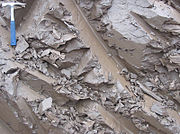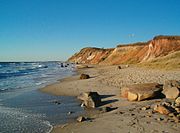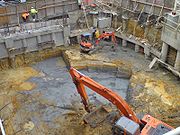
Clay
Background Information
SOS Children, which runs nearly 200 sos schools in the developing world, organised this selection. Sponsoring children helps children in the developing world to learn too.
Clay is a naturally occurring material composed primarily of fine-grained minerals, which show plasticity through a variable range of water content, and which can be hardened when dried and/or fired. Clay deposits are mostly composed of clay minerals ( phyllosilicate minerals), minerals which impart plasticity and harden when fired and/or dried, and variable amounts of water trapped in the mineral structure by polar attraction. Organic materials which do not impart plasticity may also be a part of clay deposits.
Clay minerals are typically formed over long periods of time by the gradual chemical weathering of rocks (usually silicate-bearing) by low concentrations of carbonic acid and other diluted solvents. These solvents (usually acidic) migrate through the weathering rock after leaching through upper weathered layers. In addition to the weathering process, some clay minerals are formed by hydrothermal activity. Clay deposits may be formed in place as residual deposits, but thick deposits usually are formed as the result of a secondary sedimentary deposition process after they have been eroded and transported from their original location of formation. Clay deposits are typically associated with very low energy depositional environments such as large lake and marine deposits.
Definition
Clays are distinguished from other fine-grained soils by various differences in composition. Silts, which are fine-grained soils which do not include clay minerals, tend to have larger particle sizes than clays, but there is some overlap in both particle size and other physical properties, and there are many naturally occurring deposits which include both silts and clays. The distinction between silt and clay varies by discipline. Geologists and soil scientists usually consider the separation to occur at a particle size of 2 µm (clays being finer than silts), sedimentologists often use 4-5 μm, and colloid chemists use 1 μm. Geotechnical engineers distinguish between silts and clays based on the plasticity properties of the soil, as measured by the soils' Atterberg Limits. ISO 14688 grades clay particles as being smaller than 0.063 mm, and silts larger.

Primary clays, also known as kaolins are located at the site of formation. Secondary clay deposits have been moved by erosion and water from its primary location.
Grouping
Depending upon academic source, there are three or four main groups of clays: kaolinite, montmorillonite- smectite, illite, and chlorite. Chlorites are not always considered a clay, sometimes being classified as a separate group within the phyllosilicates. There are approximately thirty different types of "pure" clays in these categories, but most "natural" clays are mixtures of these different types, along with other weathered minerals.
Varve (or varved clay) is clay with visible annual layers, formed by seasonal differences in erosion and organic content. This type of deposit is common in former glacial lakes.
Quick clay is a unique type of marine clay indigenous to the glaciated terrains of Norway, Canada and Sweden. It is a highly sensitive clay, prone to liquefaction, which has been involved in several deadly landslides.
Historical and modern uses
Clays exhibit plasticity when mixed with water in certain proportions. When dry, clay becomes firm and when fired in a kiln, permanent physical and chemical reactions occur which, amongst other changes, causes the clay to be converted into a ceramic material. It is because of these properties that clay is used for making pottery items, both practical and decorative. Different types of clay, when used with different minerals and firing conditions, are used to produce earthenware, stoneware and porcelain. Early humans discovered the useful properties of clay in prehistoric times, and one of the earliest artifacts ever uncovered is a drinking vessel made of sun-dried clay. Depending on the content of the soil, clay can appear in various colors, from a dull gray to a deep orange-red.
Clay tablets were used as the first writing medium, inscribed with cuneiform script through the use of a blunt reed called a stylus.
Clays sintered in fire were the first form of ceramic. Bricks, cooking pots, art objects, dishware and even musical instruments such as the ocarina can all be shaped from clay before being fired. Clay is also used in many industrial processes, such as paper making, cement production and chemical filtering. Clay is also often used in the manufacture of pipes for smoking tobacco and marijuana.
Clay, being relatively impermeable to water, is also used where natural seals are needed, such as in the cores of dams, or as a barrier in landfills against toxic seepage ('lining' the landfill, preferably in combination with geotextiles).
Recent studies have been carried out to investigate clay's adsorption capacities in various applications, such as the removal of heavy metals from waste water and air purification.
Medical
A recent article in The Journal of Antimicrobial Chemotherapy found that certain iron-rich clay was effective in killing bacteria.



